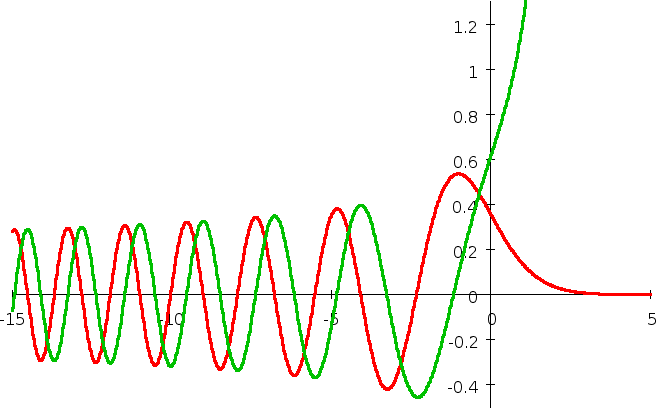Airy function
|
|
In mathematics, the Airy function Ai(x) is a special function, i.e., a function that appears so frequently that it deserves its own name. It is named after the British astronomer George Biddell Airy. The function Ai(x) and the related function Bi(x), which is also called an Airy function, are solutions to the differential equation <math>y'' - xy = 0<math>. This is the simplest second-order linear differential equation with a turning point (a point where the character of the solutions changes from oscillatory to exponential).
| Contents |
Definitions
For real values of x, the Airy function is defined by the following integral
- <math>\mathrm{Ai}(x) = \frac{1}{\pi} \int_0^\infty \cos\left(\frac{t^3}{3} + xt\right)\, dt.<math>
The integral converges even though the integrand does not die out as t → ∞ because of the rapid oscillations (this can be checked by integration by parts).
By differentiating under the integration sign, we find that y = Ai(x) satisfies the differential equation <math>y'' - xy = 0<math>. This equation has two linearly independent solutions. The standard choice for the other solution is the Airy function of the second kind, denoted Bi(x). It is defined as the solution with the same amplitude of oscillation as Ai(x) as x → −∞ which differs in phase by (1/2)π.
Properties
The values of Ai(x) and Bi(x) and their derivatives at x = 0 are given by
- <math>
\mathrm{Ai}(0) = \frac{1}{3^{2/3}\Gamma(\frac23)}, \quad
\mathrm{Bi}(0) = \frac{1}{3^{1/6}\Gamma(\frac23)}, \quad
\mathrm{Ai}'(0) = -\frac{1}{3^{1/3}\Gamma(\frac13)}, \quad
\mathrm{Bi}'(0) = \frac{3^{1/6}}{\Gamma(\frac13)}.
<math> Here, Γ denotes the Gamma function. It follows that the Wronskian of Ai(x) and Bi(x) is 1/π.
When x is positive, Ai(x) is positive, concave, and decreasing exponentially to zero, while Bi(x) is positive, convex, and increasing exponentially.When x is negative, Ai(x) and Bi(x) oscillate around zero with ever-increasing frequency and ever-decreasing amplitude. This is supported by the asymptotic formulas below for the Airy functions.
Asymptotic formulas
The asymptotic behaviour of the Airy functions as x → ∞ is given by
- <math>
\mathrm{Ai}(x) \sim \frac{e^{-\frac23x^{3/2}}}{2\sqrt\pi\,x^{1/4}} \quad\mbox{and}\quad
\mathrm{Bi}(x) \sim \frac{e^{\frac23x^{3/2}}}{\sqrt\pi\,x^{1/4}}.
<math> In the opposite limit, we have
- <math>
\mathrm{Ai}(-x) \sim \frac{\cos(\frac23x^{3/2}-\frac14\pi)}{\sqrt\pi\,x^{1/4}} \quad\mbox{and}\quad
\mathrm{Bi}(-x) \sim -\frac{\sin(\frac23x^{3/2}-\frac14\pi)}{\sqrt\pi\,x^{1/4}}.
<math> Asymptotic expansions for these limits are also available. These are listed in (Abramowitz and Stegun, 1954) and (Olver, 1974).
Complex arguments
We can extend the definition of the Airy function to the complex plane by
- <math>\mathrm{Ai}(z) = \frac{1}{2\pi i} \int \exp\left(\frac{t^3}{3} - zt\right)\, dt,<math>
where the integral is over a path starting at the point at infinity with argument -(1/3)π and ending at the point at infinity with argument (1/3)π. Alternatively, we can use the differential equation <math>y'' - xy = 0<math> to extend Ai(x) and Bi(x) to entire functions on the complex plane.
The asymptotic formula for Ai(x) is still valid in the complex plane if the principal value of x2/3 is taken and x is bounded away from the negative real axis. The formula for Bi(x) is valid provided x is in the sector {x∈C : |arg x| < (1/3)π−δ} for some positive δ. Finally, the formulas for Ai(−x) and Bi(−x) are valid if x is in the sector {x∈C : |arg x| < (2/3)π−δ}.
It follows from the asymptotic behaviour of the Airy functions that both Ai(x) and Bi(x) have an infinity of zeros on the negative real axis. The function Ai(x) has no other zeros in the complex plane, while the function Bi(x) also has infinitely many zeros in the sector {z∈C : (1/3)π < |arg z| < (1/2)π}.
Relation to other special functions
For positive arguments, the Airy functions are related to the modified Bessel functions:
- <math> \mathrm{Ai}(x) = \frac1\pi \sqrt{\frac13 x} \, K_{1/3}\left(\frac23 x^{3/2}\right), <math>
- <math> \mathrm{Bi}(x) = \sqrt{\frac13 x} \left(I_{1/3}\left(\frac23 x^{3/2}\right) + I_{-1/3}\left(\frac23 x^{3/2}\right)\right). <math>
Here, I±1/3 and K1/3 are solutions of <math>x^2y'' + xy' - (x^2 + 1/9)y = 0<math>.
For negative arguments, the Airy function are related to the Bessel functions:
- <math> \mathrm{Ai}(-x) = \frac13 \sqrt{x} \left(J_{1/3}\left(\frac23 x^{3/2}\right) + J_{-1/3}\left(\frac23 x^{3/2}\right)\right), <math>
- <math> \mathrm{Bi}(-x) = \sqrt{\frac13 x} \left(J_{-1/3}\left(\frac23 x^{3/2}\right) - J_{1/3}\left(\frac23 x^{3/2}\right)\right). <math>
Here, J±1/3 are solutions of <math>x^2y'' + xy' + (x^2 - 1/9)y = 0<math>.
The Scorer's functions solve the equation <math>y'' - xy = 1/\pi<math>. They can also be expressed in terms of the Airy functions:
- <math> \mathrm{Gi}(x) = \mathrm{Bi}(x) \int_x^\infty \mathrm{Ai}(t) \, dt + \mathrm{Ai}(x) \int_0^x \mathrm{Bi}(t) \, dt, <math>
- <math> \mathrm{Hi}(x) = \mathrm{Bi}(x) \int_{-\infty}^x \mathrm{Ai}(t) \, dt - \mathrm{Ai}(x) \int_{-\infty}^x \mathrm{Bi}(t) \, dt. <math>
History
The Airy function is named after the British astronomer George Biddell Airy, who encountered it in his study of optics (Airy 1838). The notation Ai(x) was introduced by Harold Jeffreys.
External links
- MathWorld: Airy functions (http://mathworld.wolfram.com/AiryFunctions.html)
- Chapter AI: Airy and related functions (http://dlmf.nist.gov/Contents/AI/index.html) in the Digital Library of Mathematical Functions.
References
- Milton Abramowitz and Irene A. Stegun (1954). Handbook of Mathematical Functions with Formulas, Graphs, and Mathematical Tables, (See §10.4) (http://www.math.sfu.ca/~cbm/aands/page_446.htm). National Bureau of Standards.
- Airy (1838). On the intensity of light in the neighbourhood of a caustic. Transactions of the Cambridge Philosophical Society, 6, 379—402.
- Olver (1974). Asymptotics and Special Functions, Chapter 11. Academic Press, New York.

